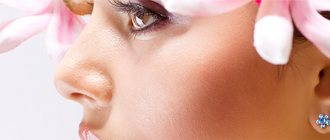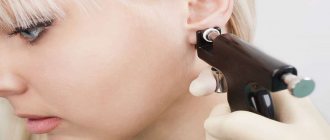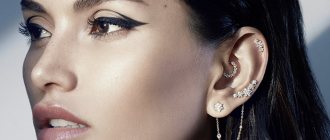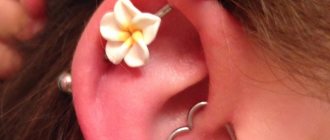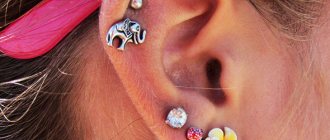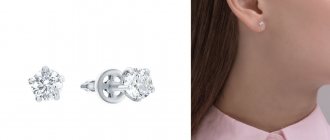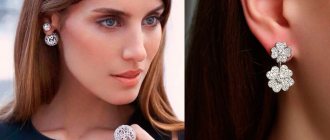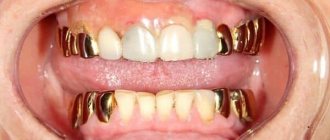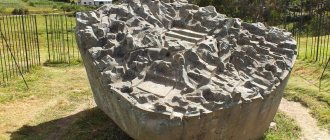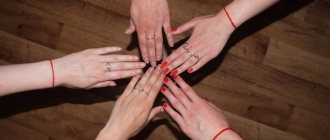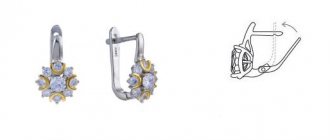The procedure for piercing the earlobes is carried out in beauty salons using a special gun, which in a split second pierces the soft tissue with medical earrings. They consist of hypoallergenic surgical steel and are kept in the ears until the puncture heals. Then you need to change them for others, but removing the accessory is not so easy. The usual way that earrings are always removed does not work in this case . How to remove them and what to do with your earlobes later, read on.
How to remove medical earrings correctly?
The process by which medical locking earrings are placed into the ear tissue is easy and painless. The result is a smooth channel for carrying accessories made of various alloys and materials. But to replace medical earrings with others, preferably gold jewelry, you will have to work hard.
Important! An adult should not remove the accessory independently. This requires outside help.
The usual method may not work - you need to pull and remove the clasp from behind with force, and this, in addition to painful sensations, can also injure the ear. This means we need to look for another way. We recommend using one of the following:
- using eyebrow tweezers. Holding the front of the earring with one hand, take tweezers with the other, place it on the antennae of the clasp and pull forcefully in the opposite direction from the ear. The clasp may not come off on the first try, and the manipulation may be repeated. To avoid injury, the tool must have blunt edges ;
- using nail scissors. Fixing the medical accessory in front with one hand, with the other we take the tool and insert its edges into the hollow “lambs” of the lock. To remove it, move the blades of the scissors apart and slide the shutter along the pin. This method is much easier, more pleasant to carry and requires virtually no time. Everything goes quickly. If you need to remove earrings from a small child, ask an assistant to back you up ;
- contacting the salon where they were installed.
Important! Before using the first two methods, wash your hands and treat your instruments and earlobe with alcohol, chlorhexidine or hydrogen peroxide.
Step by step guide on how to remove stud earrings
You need to start with a careful examination of the ear. There should be no signs of inflammation on the shell and earring: redness, swelling, discharge . Additionally, you should make sure that touching the jewelry and adjacent tissues does not cause pain.
Next we decide on the tool. If you are confident that at a crucial moment your hand will not tremble and will be able to carefully remove the stud earring with the help of an additional device, then it is worth using tweezers for the procedure. Requirements for it:
- the sides are symmetrical to each other;
- no sharp edges, only rounded ones (ideally, you should use medical tweezers, the tips of which are curved and imitate a rounded shape);
- no signs of rust, plaque, dirt;
- the metal from which the tweezers are made has hypoallergenic properties;
- The handle is comfortable and does not slip in the palm;
- Before starting the manipulation, the instrument is carefully treated with a disinfectant composition.
Further sequence of steps:
- Wash the hands;
- apply the antiseptic that was used to care for the wound on a cotton pad;
- wipe the earlobe, the area next to the puncture, and the earring itself on both sides with the disc;
- grab the front part of the earring with tweezers with rounded tips;
- with the other hand, slowly move and remove the plug (the fixing part that is threaded onto the pin of the studs);
- pull forward the hand in which the head of the stud earring is grasped with tweezers and thereby remove it from the puncture tunnel;
- treat the earlobe with an antiseptic and healing agent.
Important! The use of tweezers is generally optional. The earring can be removed using your hand. Do not use your nails, as they may slip off. It would be much more correct to squeeze the head of the stud between the index finger and thumb of 1 hand.
How long to wear these earrings?
Experts recommend not removing medical earrings for 5–6 weeks .
This period is sufficient for the formation and healing of the correct channel in the earlobe for placing jewelry made of precious metals or costume jewelry. Ear piercing is a minor medical operation that leads to the removal of a micro-section of the earlobe and the spreading of the tissue around it. If you change earrings in advance, there is a high probability of injury to the unhealed walls of the canal . An inflammatory process will occur at the site of the microtrauma, which will need to be treated. As a result, real jewelry can be worn even later than 6 weeks. This will happen only after the wound has completely healed.
What earrings can I wear later?
Much depends on how many weeks have passed since the piercing and how the healing period proceeded . If the tissues quickly recovered, the wound did not get wet or bleed profusely, and the swelling subsided within the time specified by the master, then by the time the earring stud is removed, the walls of the hole will be lined with more or less durable skin. It will withstand inserting jewelry of a different design than studs.
Important! The use of a fastener of a different design is acceptable, but you cannot use jewelry with a pin of a larger diameter.
If the recovery period proceeded with complications, then you need to choose a product with a straight, short and non-curved pin, which ends with the simplest possible clasp . The new jewelry should also be made of the same material as the old one - this way the ear will get used to it faster, and the process of rejection is unlikely to start. And don't forget to pay attention to the sample. This is important, since the sample is an indicator of the presence of impurities. If there are more of them in the second decoration than in the first, then this can cause unpleasant symptoms.
Another important criterion is pin diameter . The formed channel has the size that was given to it by the gun and the subsequent wearing of studs. Therefore, you should not put on earrings whose pins are much wider than the frame of the jewelry used during the healing of the puncture wound. This will lead to the expansion of the hole by further injuring old and barely formed new cells.
How to care for it afterwards?
After treating the canal with hydrogen peroxide, walk around without earrings for a couple of hours, let the earlobes rest and the piercing get enough air. This is very useful for forming the correct outlines. Before inserting new earrings, treat them with peroxide or alcohol.
After medical fusion you need to wear gold jewelry . This metal itself has a slight healing effect and is hypoallergenic. Gold will help heal the ears if problems arise in the future. Silver products also have many useful properties, but sometimes minor irritations and allergic reactions occur when wearing them.
The thickness of the earrings should be approximately equal to accessories made of surgical steel . For now, you can’t wear either thin or thick arches. Also avoid jewelry with English clasps. This can be done only after six months of constant wearing of gold jewelry, which is placed in the ears instead of medical jewelry.
For this period, choose earrings that will be easy to put on and take off, and the lock will be secure, but without excessive squeezing the earlobe . If, however, the decoration fits too tightly, then you need to replace it with another one.
Important! If you experience any discomfort while wearing other earrings, return to surgical alloy accessories during the healing period.
Features of removing medical stud earrings from a child
You can’t explain to your baby why you should never move during a relatively painful procedure. To prevent his restless fidgeting from leading to new damage to the earlobe, do the following (select 1 of the proposed options):
- Contact the salon and ask to remove the earring. If the child is very sensitive, it makes sense to resort to painkillers. Its application will not cause harm, since it does not have the form of injections or tablets, but comes in the form of a spray.
- Carry out the manipulation yourself, choosing the right moment. Ideal option: the child is fast asleep and does not react to touching himself.
- Before removing, be sure to make sure that there are no visible signs of suppuration. Manipulating an unhealed wound will definitely wake up the baby.
What to do if the puncture site with a pistol becomes inflamed?
Like any medical operation, earlobe piercing sometimes comes with complications: suppuration of the wound and significant redness of the skin around it. There may be several reasons - from improper treatment of the puncture site to a general weakening of the body during an infectious disease.
There are many different remedies that effectively help cure soft tissue inflammation:
- medications - ointments Levomekol, Celestoderm, Miramistin, Tetracycline, Solcoseryl, Dioxyzol solution, Chlorhexidine;
- traditional medicine methods - plantain leaf, aloe, pine resin, sea salt solution.
How long does it take for an ear cartilage piercing to heal?
Healing of the earlobes with proper care occurs very quickly - from 3 weeks to 1 month. Cartilage piercing - from 1.5 months or more, depending on the individual characteristics of the body, the quality of care and thorough hygiene.
Interesting materials:
When are birthdays for zodiac signs? When do two minuses make a plus? When is the exam 2021 physics? When is the Champions League final 2022? When was Finland part of the Soviet Union? When will the flush die? When to guess in 2021? When did Henry Ford sell the first Model T? When did Germany join the European Union? When does a tadpole turn into a frog?
Possible problems after removing earrings
Sometimes infection occurs in an already formed and healed canal. This is possible not only after the medical earrings are removed, but even several months later. The most common reasons are the following:
- injury to the earlobe with a hat or scarf;
- poor quality jewelry material;
- accessory fit too tight;
- touching the puncture site with a dirty hand;
- an untreated earring inserted into the injured canal;
- bacterial infection of the ear cartilage;
- swimming in a polluted pond.
As a result, keloid scars can form. Without proper medical treatment, infections, scarring, allergic reactions, and irritation are difficult to resist .
This is especially true for inflammation in children. Therefore, if the manifestation of swelling and redness is insignificant, then you can cope on your own. Home remedies - tea tree oil, warm or cold compress, rubbing alcohol on the inflamed area of the skin - will help with this. But if you develop a fever or rash, you should immediately consult a doctor who will prescribe a course of medication with antibiotics. Only timely and correct treatment with the help of a doctor will relieve the problems that have arisen and prevent the occurrence of complications.
Important! Experts urge not to rush into piercing the earlobes of infants. In older children, the risk of accidental injury to the healed canal is reduced.
To keep your earlobes healthy and beautiful, make it a rule to follow some recommendations for caring for your piercing:
- regularly carry out the procedure of cleansing the canal with a tampon with physiological or alcohol solution, hydrogen peroxide;
- do not touch your ears if your hands are dirty;
- wear jewelry without taking it out for a long time;
- when treating inflammation of the canal, apply the medicine, wash your hands with antibacterial soap;
- When removing clothes, try not to catch them on the earrings, so as not to injure the puncture site;
- if there is an inflammatory process around the canal, wash your hair very carefully so that dirty water does not come into contact with the wound ;
- Do not swim with lobe problems in a pool or any other body of water. Pure sea water promotes healing and cleansing, but check with your doctor first to see if this will be beneficial.
How to sew a fleece buff with your own hands
How to distinguish original balenciaga sneakers from fakes
What to do if problems arise?
Further actions after removal depend on how the procedure went. If everything is fine with your ear after removing the studs, then you should wait 1–2 hours. After this time, you can insert a new earring (don't forget to treat it before inserting it).
If unpleasant symptoms appear - severe or increasing pain in the puncture area, bloody or purulent discharge, swelling - you will have to put on old jewelry . Most likely, the healing process has not yet been completed, hence the unpleasant manifestations. You need to give your ear more time.
Important! It is impossible to leave an unhealed puncture without an earring for a long time. This can lead to the hole becoming overgrown. In the future, an attempt to insert the jewelry into the ear will result in serious injury to the canal.
If the problem is caused not by the condition of the ear, but by the immobility of the stud from which the plug was removed, then you need to proceed as follows:
- Try to soak the formations on the hidden part of the earring. Discharge from the wound accumulates, hardens and turns into strong enough clots that do not allow the jewelry to move from its place. To get rid of them, soak a cotton pad in alcohol or hydrogen peroxide and repeatedly apply its clean part to the entrance area of the puncture channel. Important! You can also soak the formations in the bath, but this method is less hygienic and reliable.
- Call another person for help. He will examine the ear and the earring he is wearing from the outside and will be able to see what is inaccessible to the wearer of the jewelry.
- If the problem is caused by a strong curvature of the back of the stud pin, then you need to take small pliers - used when working with wire - and use them to bite off the head of the decoration. It is better to sacrifice the earring than to try to remove the curved frame from a barely healed puncture and risk your own health.
These methods are used only if there is confidence that the healing process has been completed and in the absence of visible signs of suppuration . If not a single measure helps, then you need to stop tormenting the auricle and contact the master who did the piercing. Under no circumstances should you forcefully tear out an earring from your ear. Is it dangerous.
Contraindications for ear piercing
The procedure is contraindicated if you have:
- chronic diseases (diabetes mellitus, hepatitis, etc.)
- skin diseases
- severe allergies
- weakened immune system
- poor wound healing
- infection
- recent vaccination
- bad feeling
- predisposition to the formation of keloid scars
photo Ear piercing
Puncture care
Now you know how to remove medical stud earrings. But remember one thing. When you remove the earrings, the channel will be the diameter of their post. It is not recommended to insert jewelry with a thicker pin diameter. The same as earrings with an “English lock”. Otherwise, you can injure the canal and cause an infection. The lobe is an elastic and soft fabric. Over time, the diameter of the channel will acquire the size required for earrings of any design you choose.
Whatever earrings you insert, do not press the clasp too tightly to the earlobe. The result can bring big trouble.
We put on earrings without pain
Stand in front of a mirror so that your earlobe is clearly visible. Grab the earring by the decorative part with two fingers of one hand. Another is to open (or unscrew) the lock.
Use the sharp end of the lock to feel the puncture site. Gradually pressing on this area, thread the clasp all the way through. If you are wearing studs, you can try “screwing” the earring into your ear with smooth rotational movements.
For earrings with a wide lock, this life hack helps: you need to grab your earlobe and pull it down. The puncture area will stretch and become wider - it will be easier to get into. It will get wider as you wear different earrings.
Don't worry if the lock doesn't go through the hole right away. It happens that it is not located strictly horizontally, but at a slight angle. In this case, you need to shift the position of the lock until it completely fits into the puncture.
Advantages of ear piercing with the STUDEX system
The R993 gun and System 75, developed by the Studex brand, are unique modern tools that allow you to pierce your earlobe with virtually no pain. Also, the undoubted advantages of both Studex systems include:
- Complete sterility.
Both systems fully comply with all requirements and hygienic standards accepted in the world. - Virtually painless ear piercing.
The specially sharpened tip of the earring needle allows you to make a puncture in a split second, significantly reducing pain. - Easy to use.
Preparing the instrument for puncture takes literally a minute. - Safety.
Thanks to the special fastening earring system provided in the design, the jewelry will not fall out of the instrument and will be precisely fastened in the right place. A special lock that snaps the clasp into place completely eliminates injury or pinching of the earlobe during a piercing.
photo Guns and Studex earrings for ear piercing
Studex ear piercing guns and earrings
Today, one of the highest quality, safest and most reliable ear piercing instruments are the Studex systems, made in America. What is unique about this equipment? STUDEX is one of the largest manufacturers of professional ear piercing equipment in the world. Over many years of work, the company’s specialists have managed to develop reliable and high-quality instruments for safe ear piercing. For each Studex system, sterile Studex needle earrings are produced, with a specially sharpened pin, which allows you to make a puncture quickly and almost painlessly. The Stadex brand uses hypoallergenic medical steel as the material for earrings. In addition to product quality, the company pays special attention to the affordability of prices for its jewelry. In order not to increase the cost of jewelry, Studex needle earrings use not natural, but artificial stones and pearls, as well as crystal and Swarovski crystals.
photo Ear piercing. Studex needle earrings
As for the assortment, the Stadex company regularly updates its collections, surprising fans of its products with spectacular and modern designs. Earrings for ear piercing with the Studex system are available in different shapes, sizes and with different decorations to suit every taste. For small children, for example, you can choose neat needle earrings with multi-colored rolled stones. For older children and adults, jewelry with pearls, crystal, shaped earrings (hearts, flowers, stars) or jewelry with prong fastenings are suitable. In addition, for those who do not like the color of the metal, the company produces gold-plated products.
Allergy
Medical earrings will not cause discomfort. However, changing jewelry often causes allergic reactions. Inflammations may occur periodically. In this case, many girls have to remember their first medical earrings. However, some modern manufacturing companies have made a more interesting decision. For example, Studex has developed an entire Sensitive series specifically for girls with hypersensitive skin - these are hypoallergenic earrings with a lot of significant advantages.
They are not inferior in quality to medical earrings. They are made of good surgical steel. The jewelry is plated with 999 gold plating using the electroplating method. This, unlike spraying, ensures durability of the coating for up to ten years. The company offers the consumer an exquisite classic design. The earrings are decorated with zircon and Swarovski crystals.
